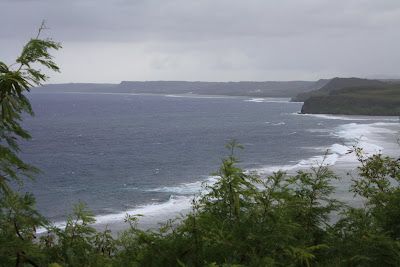
 I had a dream about spiders a little while ago.
I had a dream about spiders a little while ago.I dream about spiders a lot.
Most of my dreams about spiders involve sinister-looking gray and black spiders, which pervade the safe spaces of my psyche and veer precariously close to touching me -- a kind of psychic taboo I have yet to shed.
This dream was different. It was one of those dreams where you dream you're awake and in the room where you're sleeping, but you're obviously not.
In my dream I was in my bed, which is basically just a mattress on the floor of my apartment. And above my head there were two spider webs, with two black and red and gold spiders in them.
Even in my dream, I recognized the spiders. They are the residents of the jungle porch belonging to a friend of mine.
My friend, for whom I have to come up with a suitable pseudonym, is building a house on a half-acre patch of overgrown wild land down the road from me. The house, located on steep embankment of jungle underbrush, is really not much more than a room right now.
It is a nice room, however, with large bay windows, a sunny awning and hardwood floors that conceal magically anal retentive storage space on the floor.
And ringed with the circular metal frame of what will be a second story, and possibly a third, the house-that's-really-a-room holds enough promise of being a real house someday that it seems pleasantly habitable.
The first time I came over we constructed a fence together on his porch -- to keep in check a very large and very friendly Rottweiler he co-habitates with.
Having already taken me on a hike, during which my spider phobia was laid bare, my friend warned me ahead of the excursion about the spiders. And, of course, he had to walk me, shaking and pulling at the collar of his shirt, down an intentionally brambly path (to keep the neighbors out, of course), also populated with large, hovering spiders.
After the descent, having the deck spiders at a visible but safe distance was a bit of a relief. Still, the whole time I cut wooden fence posts with a metal power saw -- which I suspected was some kind of sly test of my constitution -- I kept one eye on the webs.
As I have been spending more time on my friend's deck, of late, the spiders have become slightly less terrifying. I still traverse the rocky hillside with my head down, staring at the ground and counting my breath until we cross the threshold of fallen trees on the main road.
But, I have given up -- almost, but not entirely -- keeping my eyes on the deck spiders, maybe more out of a psychic memory that reminds me not to tread too far in one direction or the other than actual acceptance.
Also, in my dream, I tried to keep an eye on the spiders and failed.
I would wake up -- or think that I would wake up -- and see them there, hovering. I would try to watch them, only to fall asleep again, knowing that I was at the mercy of arachnid restraint.
There was no resolution to the stalemate -- it just went on.
When I woke up, I told my friend about the dream. I told him I thought the spiders were the psychic price for spending time with a free-spirited jungle dweller, that with him came spiders.
I think this satisfied him -- if not deeply, then at least bemusedly.
Sometime after my dream, I decided to name the spiders. I was thinking something heavy handed and mythological. My friend, however, immediately shot that down.
"Something simple -- like Warren and Clyde," he said.
And so, Warren and Clyde they are.
I think the names help. I can't be certain though, as I am still on the fence about the spiders.















